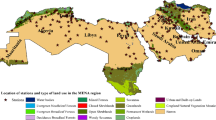Abstract
Sand-dust storm (SDS) refers to extreme events causing massive loss and damage to the social, economic, and ecological systems. SDS disaster risk assessment is important for SDS disaster reduction, especially from the regional perspective to the global scale. Based on wind speed and visibility of 9435 meteorological stations from 1982 to 2011 provided by the global surface synoptic timing data set, using kinetic energy as indicator of SDS intensity, regional aridity as indicator of background environment, and GDP, population and livestock as indicators of exposures, the global SDS risk is evaluated in terms of disaster system theory. The results show that high values of affected population risk are mainly distributed in the southeastern, southwestern, and northwestern regions of the Saharan desert, northern and southeastern regions of Rub Al Khali desert, the areas surrounding the Thar desert in western India, Iran and Turkey's desert areas, the Taklimakan desert, the farming-pastoral region in China and the Mongolian Gobi Desert, wide areas in the southwestern American deserts, the central Great Plains and the northern regions of Mexico, western coast of south America, and northeastern Brazil. The affected risk of GDP is relatively lower than population risk in Africa, and higher than population risk in coastal areas of the Black Sea, the Caspian Sea, and Bohai coastal area. High values of the affected livestock risk are mainly distributed in adjacent areas of the Saharan desert, south Arabian desert, the Thar desert, the Iranian desert, Turkestan desert, the Taklimakan desert in China, the Gobi desert in Mongolia, central and south section of Australia, surroundings of North American desert, central Great Plain, northern Mexico and west coast and northeastern parts of South America.
Map** Editors: **g’ai Wang (Key Laboratory of Regional Geography, Bei**g Normal University, Bei**g 100875, China) and Fang Lian (School of Geography, Bei**g Normal University, Bei**g 100875, China).
Language Editor: Lianyou Liu (Key Laboratory of Environmental Change and Natural Disaster, Ministry of Education; Bei**g Normal University, Bei**g 100875, China).
Access this chapter
Tax calculation will be finalised at checkout
Purchases are for personal use only
Similar content being viewed by others
References
Blaikie, P.M., C. Terry, I. Davis, et al. 2003. At risk, 2nd ed. New York: Routledge.
China Meteorological Administration (CMA). 2006. Technical regulations of sand and dust storm monitoring. Bei**g: China Standard Press. (in Chinese).
Engelstaedter, S., K.E. Kohfeld, I. Tegen, et al. 2003. Controls of dust emissions by vegetation and topographic depressions: An evaluation using dust storm frequency data. Geophysical Research Letters 30(6). doi:10.1029/2002GL016471.
Formenti, P., L. Schütz, Y. Balkanski, et al. 2011. Recent progress in understanding physical and chemical properties of African and Asian mineral dust. Atmospheric Chemistry and Physics 11(16): 8231–256.
Huang, C.F. 2012. Natural disaster risk analysis and management. Bei**g: Science Press. (in Chinese).
Indoitu, R., L. Orlovsky, and N. Orlovsky. 2012. Dust storms in Central Asia: Spatial and temporal variations. Journal of Arid Environments 85: 62–70.
Jayaratne, E., G.R. Johnson, P. McGarry, et al. 2011. Characteristics of airborne ultrafine and coarse particles during the Australian dust storm of 23 September 2009. Atmospheric Environment 45: 3996–4001.
Kalderon-Asael, B., Y. Erel, A. Sandler, et al. 2009. Mineralogical and chemical characterization of suspended atmospheric particles over the east Mediterranean based on synoptic-scale circulation patterns. Atmospheric Environment 43: 3963–970.
Kang, D.J. and H.J. Wang. 2005. Analysis on the decadal scale variation of the dust storm in North China. Science in China Series D—Earth Sciences 48:2260–266.
Liu, X.Q., N. Li, W. **e, et al. 2012. The return periods and risk assessment of severe dust storms in Inner Mongolia with consideration of the main contributing factors. Environmental Monitoring and Assessment 184: 5471–485.
Orlovsky, L., N. Orlovsky, and A. Durdyev. 2005. Dust storms in Turkmenistan. Journal of Arid Environments 60: 83–97.
Qiu, X.F., Y. Zeng, and Q.L. Miao. 2001. Sand-dust storms in China: Temporal-spatial distribution and tracks of source lands. Journal of Geographical Sciences 11: 253–60. (in Chinese).
Shi, P.J. 1996. Theory and practice of disaster study. Journal of Natural Disasters 5(4): 6–17. (in Chinese).
Shi, P.J. 2002. Theory on disaster science and disaster dynamics. Journal of Natural Disasters 11(3): 1–9. (in Chinese).
Shi, P.J. 2005. Theory and practice on disaster system research—the fourth discussion. Journal of Natural Disasters 14(6): 1–7. (in Chinese).
United Nations Convention to Combat Desertification (UNCCD). 1994. Elaboration of an international convention to combat desertification in countries experiencing serious drought and/or desertification, particularly in Africa. A. AC 241: 27.
United Nations Development Programme (UNDP), Bureau for Crisis Prevention and Recovery. 2004. Reducing disaster risk: A challenge for development. New York: UNDP, Bureau for Crisis Prevention and Recovery.
Wang, J.A., W. Xu, P.J. Shi, et al. 2001. Spatial-temporal pattern and risk assessment of wind sand disaster in China in 2000. Journal of Natural Disasters 10: 1–7. (in Chinese).
Wang, Y.Q., A.F. Stein, R.R. Draxler, et al. 2011. Global sand and dust storms in 2008: Observation and HYSPLIT model verification. Atmospheric Environment 45: 6368–381.
Wang, Y.Q., X.Y. Zhang, S.L. Gong, et al. 2008. Surface observation of sand and dust storm in East Asia and its application in CUACE/Dust. Atmospheric Chemistry and Physics 8: 545–53.
Yang, Q., L.M. Yang, G.M. Zhang, et al. 2006. Research on classification of sandstorm intensity based on probability distribution of PM10 concentration. Journal of Desert Research 26: 278–82. (in Chinese).
Zhuang, G.S., J.H. Guo, H. Yuan, et al. 2001. The compositions, sources, and size distribution of the dust storm from China in spring of 2000 and its impact on the global environment. Chinese Science Bulletin 46: 895–900. (in Chinese).




